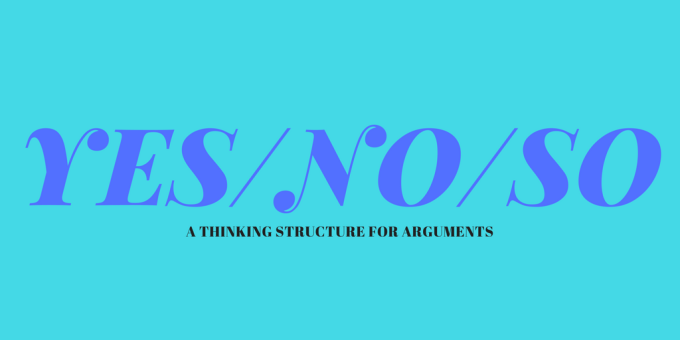Spring in AP English Language is always a little tricky. Stress levels rise among the students as the test looms, and they’re all desperately searching for the magical formula that will make it all click. It’s tough to keep them engaged in the hard work of revising and slowly improving their craft as writers when they want me to just tell them how to get a 5 already.
When I’m not working with those AP students in the afternoons, I’m working with struggling readers and writers as a literacy support coach. I experienced some similar frustrations–and the same desire for a magical formula– when working with some ninth graders on a recent argumentative essay.
In both cases, the students were frustrated with building arguments logically. They knew they had to address a counterargument, but they weren’t really sure what that entailed. They knew they had to support their claims with evidence, but they didn’t know how to order their different claims in a way that made sense. They knew some of the evidence was stronger than other pieces, but they couldn’t wrap their brains around how to weigh one piece of evidence against another.
As I worked with all of them, I realized I did have a magic formula.
Formula?? WHAT??
Before you click away in disgust, hear me out. I’m pretty anti-formula. When you teach kids a formula, you inevitably teach them to churn out essays that are boring and lifeless. Three prong theses, five paragraph essays, the whole nine yards. I’m very sensitive to teaching this formula due to one of my very first teaching gigs–the writing center in college. I’ll never forget the distraught freshman weeping in the writing center because she had too much left to say and she’d “already used up all five paragraphs.” I swore I’d never teach my students to write to a formula.
But, teaching kids to think in a systematic way is a little different than teaching them to write to a formula. My students’ biggest issue with their argumentative writing was the grey area in their topics. They realized that they couldn’t just say, “Yes, I agree because of x, y and z” because they wouldn’t be attending to their counter argument effectively. And in many cases, they weren’t always sure that they had enough evidence to definitively say Yes or No. I discovered that they needed an easy way to help them remember to weigh their evidence and come to a conclusion.

To get at this idea of weighing evidence, I’ve started teaching my students to think in terms of Yes/No/So. When faced with an argumentative writing task, first consider all the reasons why the argument may be true. Explore those ideas in a paragraph or two. Consider the evidence. Then, go the other way. Explore the opposite and put it up against the opposing viewpoint. Finally, land somewhere. So what? End your paper by coming to a conclusion. Which side was stronger or more convincing?
It’s pretty basic–and it rhymes!–but I’m amazed at the changes it has brought about with all levels of my students. Today, I was working with a young lady struggling with a World History essay. She needed to argue whether or not imperialism was ultimately good or bad. She is not a confident writer at all and didn’t know where to start with the lists and lists of facts in her notes. She had no idea how to organize, so I walked her through Yes/No/So:

That conversation took about five minutes and she was off and running, ready to write independently and confident that she knew where to go with her argument. With previous essays with the same student, I’ve tried complicated graphic organizers and detailed outlines. Nothing has ever worked particularly well, and, quite frankly, we’ve both been frustrated. When I simplified and gave her a “formula” to help her structure her thinking, though, she was able to quickly move to independence. Her finished essay–which she proudly shared with me just moments ago–had four paragraphs: an intro, a paragraph about the “yes” evidence, two paragraphs dedicated to the “no” evidence, and a conclusion that clearly articulated her “so.” It was a complete argument, it made sense, and it built to a natural conclusion. I never had to tell her how many paragraphs she needed because she just wrote as many as she needed to make her point.
With my stronger writers in AP, they’ve latched onto the thinking structure and used it to help them create more sophisticated, layered arguments. Since they’re always thinking with the “so” in mind as the end point, they’re weighing the arguments as they go and using their transitions to build their arguments rather than just connect the dots. It pushes them to always think about where they’re going to land at the end of the essay so that their essay isn’t missing the oh-so-important “so what?”
I think this kind of thinking comes naturally to most of us as adult writers and thinkers, but using this simple rhyme with my students of such a wide range of abilities has been a teaching a-ha moment for me. Sometimes students just need simple ways to help them organize their thinking. It’s a little tool they can tuck away and take out of my room for any argumentative situation they find themselves in. Rather than give them formula into which they’ll force their evidence, they have a structure to push their thinking to be complete. What do you think? Well, Yes…No…So.
–Hattie
So..Do you have any little tricks that seem small but make a big impact? I’d love to add them to my toolbox! Please share below or on Twitter @TeacherHattie.

Another fabulous strategy, Hattie! You are truly an inspiration for teachers everywhere!